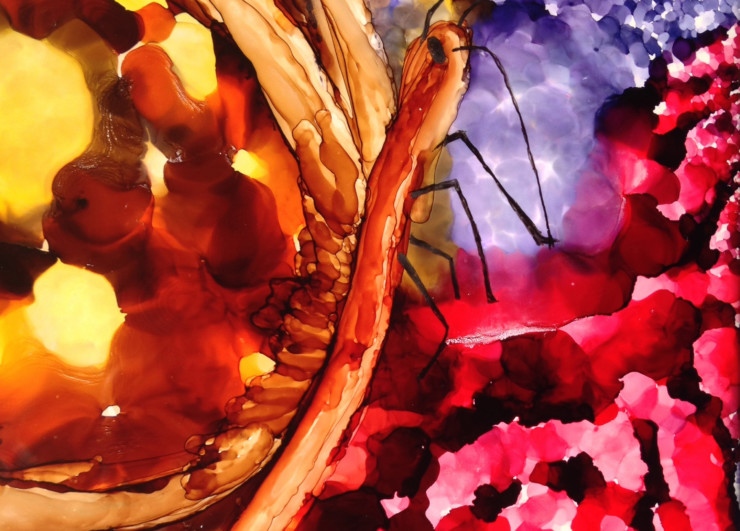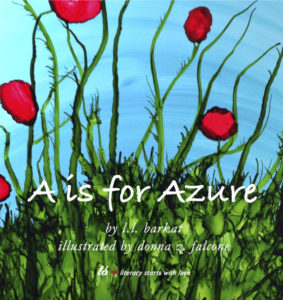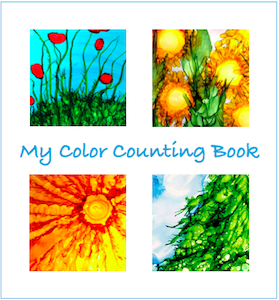There are over ten million colors in the world, and that’s just the ones we can see. We tend to learn about the basics, but why limit ourselves? Colors have cool histories, intriguing origins, cultural meanings, wonderful names. Plus, they are often quite beautiful. And beauty is showing promise as a way to help kids (and us!) learn.
With all this rich possibility swirling in the world, we invite you to take a journey into colors—whether you are 5 or 50 or even 85. Use them to teach yourself fascinating things about history, science, language, and culture (maybe even math!). Go on color treasure hunts, taste them or tinker with them. We’re here to send you on your colorful way, continuing our color journey with vermilion.
Of course, in our very own alphabet book, we also include old favorites like red, orange, yellow, green, blue (as part of the denim page) and purple. But with 26 letters to illustrate, we also saw a beautiful opportunity: to paint the world from an azure sky to a zaffre goodbye.
How to Pronounce Vermilion
5 Fun Facts About Vermilion
1. Vermilion derives its name from the Latin vermis, or worm, because of its similarity to a red dye created from grinding up an insect. The word has the same root as our word vermin, though these days we might not think they have much in common.
2. The color vermilion was originally created from pulverizing the mineral cinnabar. Cinnabar contains mercury, which gives it its bright red color.
3. That mercury didn’t just brighten up the cinnabar, but also made it deadly. The ancient Romans used prisoners to mine cinnabar, since working with the mercury ore was “a virtual death sentence.”
4. Vermilion was used by various cultures throughout history, beginning as early as 8000 B.C. The Chinese used it to decorate ceramics, paint walls and also in rituals. Romans used vermilion in paintings, home decor and cosmetics. In the Americas, vermilion was found covering the body and artifacts in the Mayan Tomb of the Red Queen.
5. Vermilion is also known as Chinese Red. Taoist culture considered vermilion to be the “color of life and eternity.”
Take a Color Walk
One great way to become more attuned to the colors around you is to take a color walk. It’s easy to do: simply decide on your color-of-the-day, and look for it wherever you roam. Take pictures, jot notes, or just keep your findings in mind. If you feel so inspired write a color vignette when you get home.
Count Your Colors
For younger color walk participants, we’ve created a special My Color Counting Book that reinforces color names, days of the week, sorting, counting, and adding. Just print and enjoy, at home or for a math or literacy center in the classroom!
Vermilion Haiku Poetry Prompt
Try your hand at a vermilion haiku. Use the “fun facts” or findings from your color walk as inspiration if you like. Need more inspiration? Check out our haiku infographic.
Brilliant ink-on-tile illustrations created with a secret process bring the alphabet to colorful life. Children will delight in the rich, poetic language of colors like emerald, jasmine, and quartz—while also meeting old favorites like yellow, orange and purple.
Related Article at Huffington Post: 5 Great Reasons to Color the Core of Kids’ Learning
- Free E-Book + Poetry Prompt! - April 14, 2025
- Braving the Poem: Interview with Catherine Abbey Hodges - March 24, 2025
- National Poetry Month Is Here + Prompt! - March 14, 2025



Katie says
My dear hubby ordered a copy of A is for Azure for me and it came yesterday. Beautiful, colorful, lovely:):):)
Eager to share it with the grands!
L.L. Barkat says
Katie, that is so sweet of your hubby. A colorful gift, to create connections! 🙂
Katie says
From antiquity
you have decorated skin,
paintings, clothes, dishes
Katie says
Mined, crushed to powder
Vermilion or cinnabar, you
come from everywhere.
Katie says
North or south, east, west
Vermilion artifacts lie
waiting to be found.